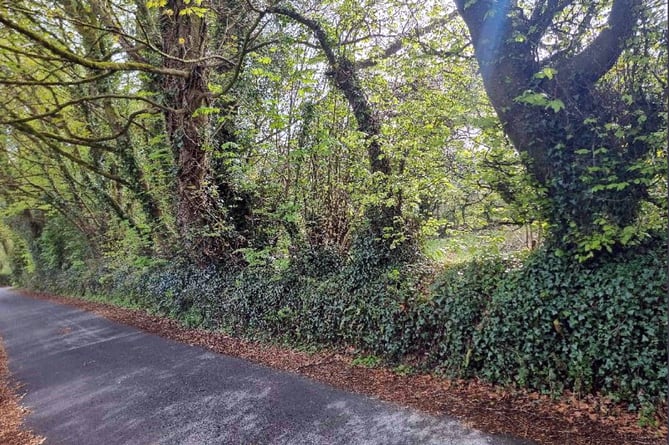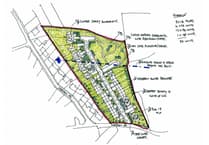PA23/04257: Plans for the conversion for a garage into a residential accommodation annexe for the elderly father of the residents at a property in Bodmin were hotly debated at a recent Bodmin Town Council planning meeting.
Bodmin Town Council’s planning committee were discussing the proposed development at 14 Foulston Way, Bodmin, by the owner of the property, Mr James Mercer.
At the meeting, where Bodmin Town Council would decide whether it would support or object to the proposal by Mr Mercer, representations were received from both the applicant and three neighbours, all of which wished to object to the proposal.
Chief among the concerns of those objecting were fears that the conversion would lead to an overdevelopment of the area, located on land that was once home to the vast St Lawrence’s Hospital site with 14 Foulston Way a property which was built alongside the retained historical buildings.
Central to these fears were plans that a withdrawn proposal by the property’s former owners, Mr and Mrs Kappes, to convert the garage into a separately rented property would increase traffic on what is an already congested road, in their view. They also believed the previous application would have become an ‘Airbnb’ style letting if allowed.
The residents who objected, namely Daniel Fitzpatrick, Stuart Brown and Paul Turner, felt that allowing the garage to be extended and redeveloped into its own living accommodation, whether similar to the previous proposal or this, would cause a precedent for other garages to be debated.
Mr Fitzpatrick told Bodmin Town Council that: “If this planning application was allowed, what is to stop other properties doing the same? There are 14 properties on Foulston Way, and if one can do it, that means all others can and you’d have 28 properties where there was once 14”.
Mr Brown said that there was a real strength of feeling from residents on Foulston Way that a development like this was not appropriate for the area, while Mr Turner said there had been issues with sewage in the area with blockages in the Victorian era sewer system being a persistent problem which this would exacerbate.
After the three objectors had stated their concerns, Mr James Mercer, the owner of the property took the opportunity to allay the concerns of his neighbours while also explaining to the Bodmin Town Council planning committee, chaired by Councillor Pete Skea, why this development was needed.
He told the planning committee that unlike the previous owners of the property, he wasn’t trying to turn the garage into a separate house or a two storey building and that the only visual difference externally would be the extension of the garage door by 1.2 metres forward in order to fit a kitchen into the property for his wife’s elderly father to occupy as a “granny annexe”.
He added that the only reason the application had come back was due to the required addition to the kitchen and that the planning committee had previously supported his plans.
In order to alleviate the fears of his neighbours, Mr Mercer revealed that he had drawn up a legal document that would ensure that in the event of planning being granted, the property could not be used for any other purpose than his intention to provide accommodation for his elderly father-in-law.
He also said he would be expecting that in any granted planning permission that a condition of planning permission would be that the annexe could only be occupied by family members and not to be used or sold as a separate property and that privacy of neighbours would be respected with the use of obscure glass.
Upon discussing the application after the representations, the Bodmin Town Council planning committee had their say.
Cllr Craig Rowe welcomed the application, saying as the application was, he supported it, adding that in his view, there was a chronic shortage of housing for the elderly and that with planning applications meant to be assessed on their merits, if the nature of the application was to change, he would review that support accordingly.
Cllr Liz Ahearn said she had severe concerns about drainage and parking at the property, with the latter a concern shared by Cllr James Burden.
Bodmin Town Council later voted to support the planning application, with three councillors in favour and two against the motion, telling Cornwall Council: “Bodmin Town Council Planning Committee resolved to support this application having taken into consideration points raised by both the applicant and residents in the area.”
The application is awaiting the final decision from Cornwall Council.
PA23/04776; An application for the partial removal of a hedgerow in Drakewalls, near Gunnislake has been refused by Cornwall Council.
The applicant, Mr Christopher Morgan had applied to Cornwall Council for the partial hedgerow removal at his property on land at the rear of Duntreva, Stony Lane, Drakewalls, Gunnislake.
He said to the local authority’s planning department: “I would like to apply for a partial hedgerow removal to provide an access gate of 14 feet into my field for a horse box and farm machinery.
“This is because the gate further down the hill has limited access. The existing hedge is only one metre high and includes a small rotten tree and some new shoots that are two metres high.”
However, Mr Morgan’s application for the hedgerow removal fell foul of objections from consultees taking part in the application process, with concerns that the hedge set to be removed is, in fact, considered an “important hedge row”.
Steve Harding, the Tree Officer in the Council’s forestry team, commented: “I have undertaken an assessment of the hedgerow associated with this application and can confirm that it meets the requirements set out in the 1997 regulations to be considered an important hedge on several counts.”
Calstock Parish Council also added an objection to the application, saying: “The Parish Council wishes to object to this application due to the removal of a Cornish hedge contrary to Calstock NDP EBD 2.3 Trees, Cornish Hedges and Hedgerows and also there are other means of access not just this gate. We also support the Tree officers comments.”
An accompanying report by an officer in the Cornwall Council’s planning department concluded: “The hedgerow is considered to be important for the purposes of Section 97 of the Environment Act 1995 as it has existed for more than 30 years and meets criteria 5(a) of Part II of Schedule 1 of the Hedgerows Regulations 1997.
“The removal of this hedgerow would lead to significant harm impacting on the landscape character of the Area of Outstanding Beauty. This harm is not outweighed by any overriding justification. As such, also noting the hedgerows are considered to be “important”, under the hedgerow removal act, the presumption in favour of retaining hedgerows applies, and it is recommended that a hedgerow retention notice be issued.”
Cornwall Council issued the hedgerow retention notice on Mr Morgan, and in refusing the application told him: “On 11 June 2023 you gave notice under regulation 5(1)(a) of the above Regulations that you proposed to remove the lengths of hedgerow indicated on the plan(s) attached to your notice.
“Cornwall Council, now gives you notice, under regulation 5(1) of the said Regulations, having taken into account the reasons put forward for the removal of the hedgerow, that it is not satisfied that there are circumstances which justify the removal of the hedgerow, and consequently the work specified in your notice may not be carried out, and further that the said length of hedgerow must be retained and removal consisting of or including any such work is hereby prohibited.
“The hedgerow in question is considered to be important as it has existed for over 30 years and meets criteria 5a of Part II of Schedule 1 of the Hedgerows Regulations 1997.
“The removal of any section of this hedgerow will have a notable adverse impact on the natural and historic landscape character of the area (designated as an Area of Outstanding Natural Beauty), which is not outweighed by any clear benefit.
“The removal of the hedgerow therefore fails to comply with policies 2 and 23 of the Cornwall Local Plan Strategic Policies 2010 - 2030 (adopted November 2016), paragraphs 174 and 180 of the National Planning Policy Framework 2021 and policy C1 of the Climate Emergency Development Plan Document 2023.”




